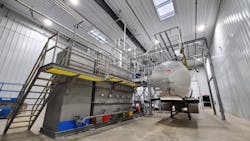Confined-space entry in tank-cleaning operations remains a hazardous occupation, leading the Occupational Safety and Health Administration (OSHA) to renew its interest in evaluating the safety efforts of regulated facilities.
The latest push includes Regional Emphasis Programs (REPs) in Regions V and VI that target the transportation tank cleaning industry.
But the truth is the industry’s long been on the agency’s regulatory radar, with one transportation-focused lawyer saying it was on OSHA’s “blacklist of industry sectors,” and that its officials “believe most wash racks are unsafe,” during a National Tank Truck Carriers presentation on confined-space entry more than a decade ago.
It’s no surprise, then, that one tank-cleaning expert wants to eliminate confined-space entries altogether.
“We can train and train, and teach and teach, but if you can eliminate it, that’s the best way,” said Brian Bollinger, Quala’s vice president of environment, health, and safety.
Bollinger said Quala is investing in new technology, like high-definition cameras and high-pressure sprayers, that keep workers from ever needing to enter potentially hazardous confined spaces to ensure they’re clean. He also said they’re using alarm systems with motion detection, and monitoring all employees’ oxygen levels at specialty locations.
After all, new equipment and technology are expensive—but human lives are invaluable.
So is expert insight in promulgating best practices in tank-cleaning safety.
That’s why Bollinger joined Ken Cooper, operations director with Trimac’s National Tank Services, and A-One Chemicals’ Ed Wickham, chairman of NTTC’s tank cleaning council, for a roundtable discussion of OSHA’s regional emphasis programs, their reaction to the new push, and the importance of establishing a safety culture that stretches across all levels of an organization during NTTC’s 2021 Tank Truck Week in Dallas, Texas.
The confined space entry roundtable was led by Jerry Curl, director of operations for G&D Trucking/Hoffman Transportation.
Questions and answers are edited for space and clarity.
Curl: Are you changing your approach to tank-cleaning safety under the new REP?
Bollinger: “We’re going to stay consistent with our approach because we’re coast-to-coast and touch locations in many states. Our standardization and focus, and being consistent from coast to coast, doesn’t change in any way, no matter what this emphasis program unveils to us. I asked a loaded question of Mr. (Stephen) Boyd (OSHA’s deputy regional administrator for Region VI), about it being beyond two of the regions that are transparent about it, and it’s for real. It is a national emphasis program. We just don’t know it yet. We have received independent letters in other locations, in other states, outside of the region. So I would just give a heads up to everybody. We’re all in this thing together, and it will touch many more states. Your state-ran program locations will follow within six months, if not sooner.”
Cooper: “Our goal, of course, is to make sure every employee gets back home every day just like they came in. But we’ve had a lot of emphasis lately on confined-space entry. We’ve looked at all of our policies, and trainings. We’ve tried to put in some control mechanisms to prevent unauthorized tank entry, and that’s a personal goal of mine. How do we prevent an unauthorized entry? Because it’s normally not the one who is well-trained and doing what they’re supposed to do. It’s the one who’s going off script. And that’s what we want to try to prevent. So that’s really our goal. As far as this emphasis program, we’ve been jumping into this for years now … so there’s nothing really changing for us.”
Curl: How do you ensure employees are following safety guidelines, especially at 3 a.m. after a long shift?
Cooper: “Part of it is training, part of it is controls. We train, and then do a competency. We audit permit files. We have software where we’re scanning it in, and we audit that. We also have the technology with our meters that shows us when the meters are being used, so we can use that to work knowledge in as well. And then we put in controls so that you can’t just go and do an entry. Somebody has to know, and it has to be a supervisor who allows that to happen.”
Bollinger: “It does naturally fall back on the culture of the individual locations, and just holding each other accountable. We do have a stop-work authority that we tie into our personal safety commitment that our employees sign. We encourage them, if you see something, say something, in hopes of all of us going home to our families every single day.”
Curl: Are tank washes attacking this issue aggressively enough? Are they getting the message?
Wickham: “I see all different things. Each tank-cleaning facility has a similar but unique approach to confined-space entry. Each one of them uses a little bit different equipment, maybe a little bit different training process. But the biggest difference I see across the board is a wide variety of cultures. And the culture is what needs to be more standardized in order for all of these different programs to be effective and work all the time. So I encourage each and every one of you, if you don’t know your culture, find out about your culture, and see if there are any areas you need to address.”
Curl: What are key performance indicators you use to evaluate program effectiveness?
Bollinger: “When we have a stop-work authority situation that occurred, or a near miss occurred, we want to step back as an organization and consistently do an incident review on those, and not just high-five ourselves for dodging a tragedy. So it’s continuing to dive deep into root-cause analysis of those near-miss and observation situations, vs. waiting until it gets to an injury level.”
Cooper: “We do what we call JTOs—job-task observations. We have all of our managers, and our employees do peer-to-peer JTOs. We also do the near-miss and find-and-fix program. That’s been really helpful to us over the last 18 months, and we take those findings from near misses and share them across the entire network, so that we learn from each other. We also do the audits. We have a safety specialist that comes in for permits, and the data coming off the meters, to make sure the times match up to the permits, and we do those audits for the accountability. But to the safety culture, it’s the find and fixes, the near misses, performing the job-task observations, and getting your people at the line level involved, and not just your managers.”
Curl: Some atmospheric meters are complicated. Do you do your own training, or do you bring in the equipment manufacturer?
Cooper: “We’re using Industrial Scientific right now, and when we initially brought them on, they did come in and do training with us. Now it’s part of our normal confined-space entry training.”
Bollinger: “We’re the same. Our meters are sophisticated enough that we can pull data from any given day or week, and review those results. So we use that information to retrain. One thing that (risk consultant Kenny) Ray challenged us to do is go above and beyond, and we do that in training. We do a quarterly, hands-on mock rescue process, we require it for every employee, and we emphasize non-entry rescue. So we require every single employee to put their hands on the equipment, to know how to actuate it, and actually use the equipment above and beyond a pre-use inspection that would be required. And on a six-month basis, we have a classic, standard training program for confined space, and then on an annual basis, we have our regional EH&S professionals dissect every one of those programs. We believe that keeps us ahead of the curve on education.”
Curl: How do you manage rescue training?
Cooper: “Rescue training is a part of our confined space entry program. We have cite-specific rescue procedures and training that is developed between safety and cite management, because every cite is different. Sometimes you may have different rescue equipment. We go through quarterly mock drills as well, and then annual training on top of that.”
Curl: Are wash racks making sure well-maintained rescue equipment is readily available in an emergency?
Wickham: “I see some facilities that are maintaining their equipment. It’s in really good working order, very accessible. And then of course I see the dusty equipment, and hear ‘Oh well, I don’t know if I know how to work that or not.’ So it’s a wide range. So I encourage each one of you to look at your culture, and at your training. When I was in operations, which is where I spent the bulk of my career, I would take the smallest person on the shift—and this is for those who are going to self-rescue—and put them on the crank, and put the biggest person in the tank, because that’s what’s going to happen in real life. They’ve got to be able to extract that person, along with the other folks on that shift. And they have to understand everybody gets on the crank. It was tedious, it took a long time, it disrupted production with our customers—but everybody is either in the tank with a harness on at one time, or on the crank.”
About the Author
Jason McDaniel
Jason McDaniel, based in the Houston TX area, has more than 20 years of experience as an award-winning journalist. He spent 15 writing and editing for daily newspapers, including the Houston Chronicle, and began covering the commercial vehicle industry in 2018. He was named editor of Bulk Transporter and Refrigerated Transporter magazines in July 2020.


